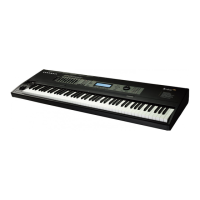2-8
Triple Modular Processing
Editing Triples
Layer 2 gets applied after the signal from Layer 1 joins the signal from Layer 2. Consequently,
Layer 2’s amplitude envelope affects Layer 1’s sound as well as Layer 2’s sound.
EditProg:ALG|||||||||||||||<>LyrT2:2/3||
||||||||||||||||||||||||||||||||||||||||
Algorithm:65|||||[Triple,|layer|2|of|3]|
||||||||||||||||6|||||||||||||||||||||||
qwwerwwtqwwerwwt7wwerwwtqWWERWWTqwwerwt|
dPITCH|gkNONE||i;XFADE|gkAMP|||©kALPASj|
cvvvvvVbcvvvvVvbnvvvVvvbcvvVvvvbcvVvvvm|
<more||F1|OFF|F2|XFD|F3|AMP|F4|FRQ|more>|
Figure 2-4 AMP block after input point
Amplitude Envelopes and the Keymap in Layer 3
Since Layer 3 of a triple always ends with an AMP block, triples always apply Layer 3’s
amplitude envelope, which may override the effects of any amplitude envelopes in Layers 1
or 2. The effect of Layer 3’s envelope on the sound of the triple depends on whether Layer 3 uses
a natural amplitude envelope or a user-defined one. When Layer 3 of a triple uses a natural
amplitude envelope, the keymap used in Layer 3 determines the final amplitude envelope for
the triple (because the natural amplitude envelope is stored as part of the keymap). In other
words, changing the keymap for Layer 3 changes the amplitude envelope. This is an easy way to
use alternative amplitude envelopes—for example, applying the amplitude envelope of a piano
to a guitar sound generated in layer 1 or Layer 2. If you use a user envelope in Layer 3, it doesn’t
matter what the keymap is; changing the keymap doesn’t change the amplitude envelope.
The Natural Amplitude Envelope
Look at the AMPENV page for Layer 3 of the triple. If you see the default (natural) amplitude
envelope (that is, if you see only the Mode parameter with a value of Natural), the natural
amplitude envelope of the keymap used in Layer 3 defines the final amplitude envelope for the
triple. So if you assign a piano keymap to Layer 3, the piano keymap’s amplitude envelope
affects the sound of the entire triple—possibly overriding the amplitude envelopes of Layers 1
and 2. On the other hand, if you use a keymap that doesn’t produce a sound (like 0 None or
168 Silence), the triple produces no sound at all.
Note: When you’re using the Layer-3 keymap’s default (natural) amplitude envelope, changing the value
of the Xpose parameter on the KEYMAP page for Layer 3 changes the scaling of the amplitude envelope,
and consequently, the sound of the triple. In general, raising the value of Xpose decreases the duration of
each amplitude-envelope segment, while lowering the value of Xpose increases the duration of each
segment.
The User Envelope
You can use one of your own amplitude envelopes instead of the layer’s natural amplitude
envelope. On the AMPENV page for Layer 3, change the value of the Mode parameter from
Natural to User. This removes the default amplitude envelope, and applies a user-defined
envelope according to the values of the parameters on the AMPENV page (Att1, Dec1, Rel1,
etc.). In this case, it doesn’t matter which keymap you assign to Layer 3.

